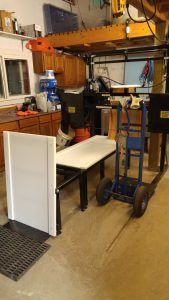Ice like you never knew it
We’ve all done it, at least if you come from the prairies…getting your tongue stuck on ice. I did. One of five boys I distinctly remember playing horsie on the skating rink our Dad had made for us on the front lawn. All good until I bent down to “lick straw.” My tongue stuck fast to the ice. Not having the presence of mind or common sense to think through the solution I yanked back with all my equine force leaving a piece of my tongue there in the ice. So I’m not surprised when I hear, usually younger people prompting each other to lick the ice sculpture after I set it up. Their fear is well warranted, more so than their understanding of ice.

Ice only sticks to something when it is at colder than freezing temperature and the object it is adhering to is wet. Most of the time when the ice sculpture is standing their glistening in room temperature (glistening because it is wet on the surface) the outside of the ice is not below freezing temperature anymore. You could just as well lick a hole into the ice and it wouldn’t stick to your tongue.
We’re still learning things about ice. From start to finish we are handling water that is anywhere from -25 degrees to somewhere above 0 degrees. And how it behaves at different temperatures is quite distinct. For example, last week was really hot outside. Inside our ice manufacturing shop was even hotter with all the block makers running. So when I harvested a block of ice and placed in on the band saw table and proceeded to trim it down to the desired 10 inches there was a sickening “crack.” In a fraction of a second the entire block had shattered. That’s right, fractures running every which way through the block rendering it useless for a sculpture. I should have known better. It’s called thermal shock. When the temperature difference between the inside of the ice and the tools (in this case the saw blade) as well as the surrounding air temperature is too distinct, the ice just can’t cope and shatters. It’s been said that you can crack a 300 pound block of ice with your bare hand.


Hence the thing we call “warming up” ice. That means leaving the ice alone in the block maker once we’ve taken off the ultra-cold water so that it can temper enough to endure treatment with a mechanical tool. I’ve stopped counting the number of times that I’ve done a live carving during which I plunged a chainsaw into a block of ice in front of a bunch of mall shoppers only to hear that wretched “crack.” Patience is the moral of the story. Wait till the ice has at least stood in room temperature for a half an hour or more and gotten wet before starting to man handle it.


The same thing is true when we harvest ice from the block makers. You dolly them into the freezer to warm up. Yes, that’s what I said, warm up. You see, the inside of the freezer is usually around minus 10 degrees which is about 15 degrees warmer than the block makers that freezes the ice. Here’s a little experiment; prepare two cups of water. Fill one with warm water and the other with really cold refrigerated water. Now take two ice cubes out of the freezer. Immediately drop one into the warm water and the other one into the cold water. Watch the response. Thermal shock!
I love working with ice. It’s an art medium like no other. It can be relentlessly uncompromising (just try running your hand across a jagged piece of ice or dropping it on your foot) and beautifully forgiving at the right temperature. You should see me hack and saw and generally put the ice through its paces enroute to becoming an ice sculpture. And did you know that water is the only element that expands instead of contracts when it freezes? My childhood serves me with one more memory. Whitewater Lake was not far away from our homestead in southern Manitoba. Being a large shallow lake it often froze through to the bottom in winter. And the effect was astounding. As it froze the ice literally expanded outwards beyond the shoreline pushing up huge mountains of jagged shards.
It’s all about knowing ice. How many times I’ve been approached by a keener who has done wood carving or chocolate carving assuming that their chisels are fit for the task. Nope…different chisels, different bits, different lots of things. This is ice folks. We’ve been at it now for 12 years and I’m still experimenting and learning.
Thank you for reading! Until next time… #theicemen
